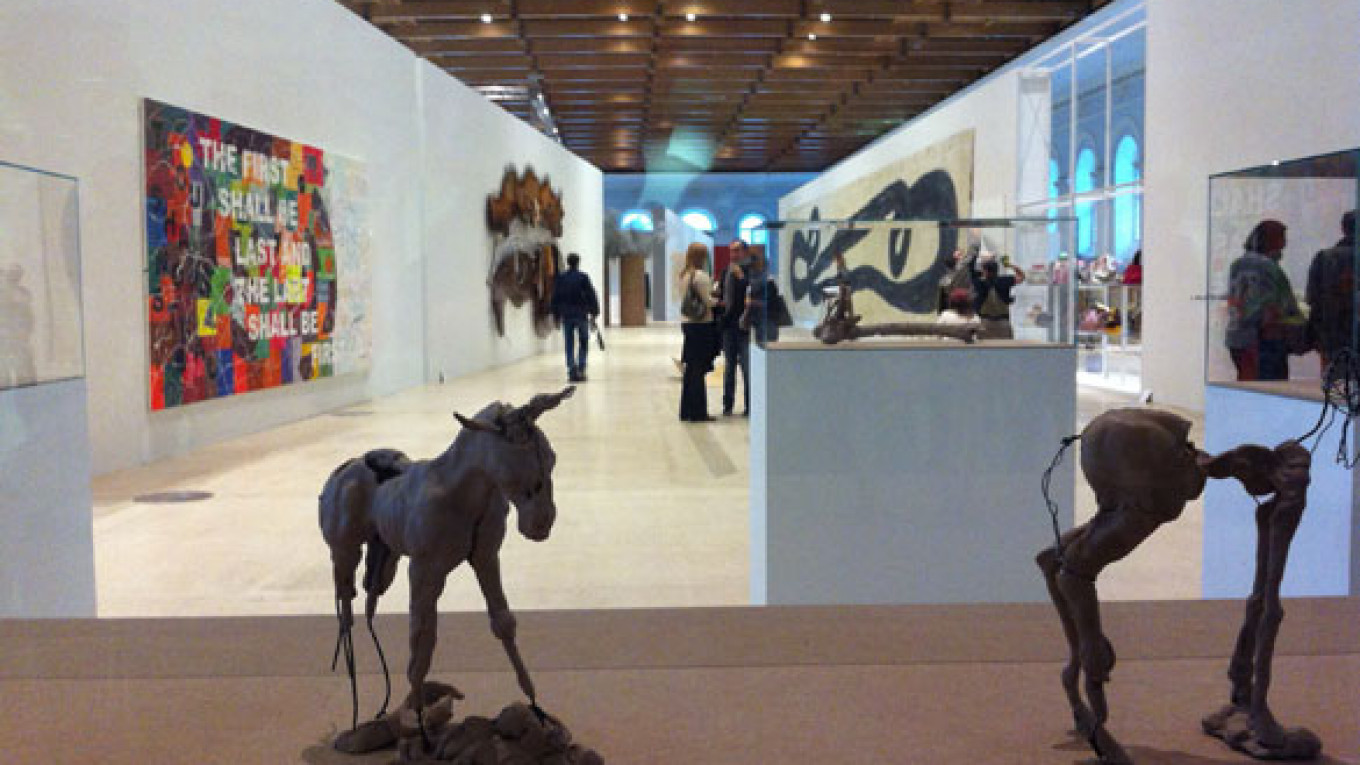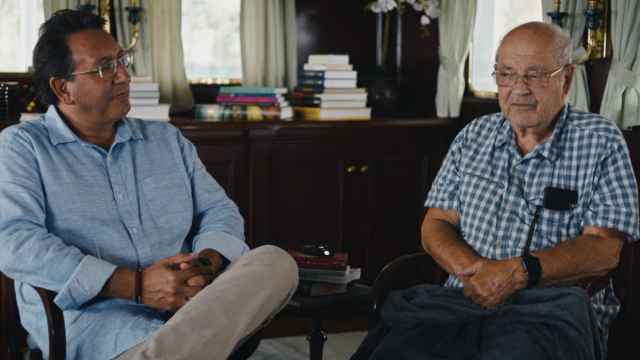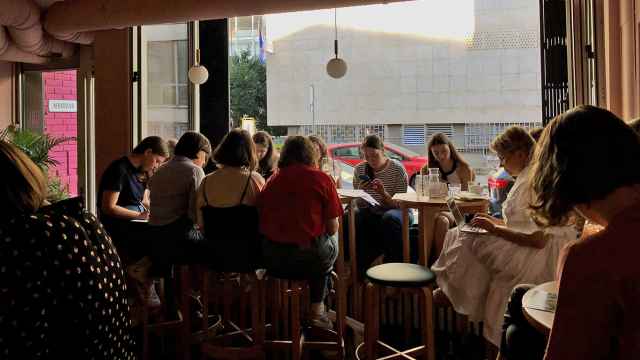While the Fifth Moscow Biennale of Contemporary Art begins to come to a close, The Moscow Times met with Catherine de Zegher, the curator of the main project of the Biennale, "More Light," which is on display in Moscow's Manege.
De Zegher has previously served as artistic co-director of Sydney Biennale, and from 1999 to 2006 was the executive director and chief curator of The Drawing Center in New York. She has also been curating several projects of artists from the Middle and Far East, with forthcoming exhibitions from two contemporary Indian artists right after the Moscow Biennale. Even this information would be reason enough to think that Catherine de Zegher is someone with a classical outlook in the contemporary world and a careful approach to presenting projects that have multidimensional aesthetics. It all stands for the effort and devotedness of the curator who has managed to put together works from over 40 participants under a single defining idea, which sometimes even transforms the original message of the works.
Q: The title of the main project is "More Light." The upper floor of the Manege is a giant space filled with light, and the lower floor is a dark space where you contrast light with darkness and play with the aspects of the fear of darkness. Did the idea of this comparison emerge when you first saw the spaces of Manege, or did you have it beforehand?
A: As a curator, I never start with a theme, especially for these large-scale exhibition projects. I start with conversations with a lot of artists, and in these encounters I try to capture a currency of thinking, something that is in the air, and a consideration of many issues that are here and now in society. Using concepts of time and space as guidelines, the process itself shapes the project. So I do not illustrate a theme, rather diverse concepts and elements come together and shape the project. And the title comes about at the same time.
Of course, when I saw the space of Manege, I immediately reacted: "What a luminous space!" However, if you read the text in the catalogue, you will find out that, at first, I wanted a title including the word ''square", but the significance of ''square'' in Russian is not the same as in English. So the commissioner wanted to drop it. And then I just went with the flow of the building, of the space-time issues I was working on, considering the energy that was generated because light is also energy.
When you come in the Manege, you are overwhelmed by the immensity of this luminous space, which at the same time is dwarfing as it makes everything and everyone small.
Needless to say, it is a very difficult space. And when I went downstairs, I thought: "This is such a heavy modernist and dark space, how am I going to deal with this?" I thus decided to make the room darker. Actually, I didn't immediately make that connection between darkness on the lower level and light on the upper level, it just happened. Sometimes things are so obvious but only become clearer as you work.
In addition, on the lower level, I considered drawing as transition to light, to the opening of consciousness. Drawing remains very important to me, because drawing represents a very common gesture: it's something everybody can do. Therefore I asked 3 artists to make a collaborative drawing, connecting the very personal gesture with the collective gesture. The visitor moving through this space will feel an urge to go to the wall where the light is with the collective drawing. While at the same time video viewing the films dispersed throughout the space about slow time and slow attention. Consequently, in a way, the attention of people becomes sharper and the pacing downstairs allows for awareness by the time they come up to the upper level.
Q: So there is a specific order in which the exhibit should be viewed?
A: Yes, therefore I really envisioned people going downstairs first, and I hope the organizers properly indicate this idea. It also seems more logical as you leave your coat in the cloakroom and immediately face the exhibition project. Richard Tuttle, an American artist I worked with, once said to me: "You have a very good relationship with chaos!" At first, I didn't understand what he meant, but now I increasingly know that as curator you are often faced with huge chaos, and then things slowly begin to take shape as you go with the flow. And you have to believe in that process. Most of our society is geared towards a final shape at the beginning, yet I tell everyone that the shape comes along with the development of an idea.
Q: In order to display these aspects of space and time, you also had to deal with time literally by installing the art objects in just a couple of weeks. At the same time, it often takes years to prepare a work of contemporary art and display the result. What was your personal feeling of time during the preparation? Because a curator is also an artist to some extent …
A: I do not say this, as I think making art is one of the most difficult undertakings, at least compared to what I do. But I learn a lot from artists, that is true.
When I worked in Australia on the 18th Biennale of Sydney, I considered it crucial to visit the country, to go to the Central Desert and Arnhemland, as I believe that a project emerges out of an attitude towards life that is empathic with the other and the land, rather than in trying to dominate a situation or to master it. I was very struck — and I had read about it — how the notions of time and space of aboriginal people are so different from the ones the so-called settlers have. An aboriginal person is completely in the present as he has to survive in an environment that seems very hostile to us. What does this mean? They say that the future is a mystery — while we often think that know what our future will be, since we plan it and have expectations, ideals of life. But they do not think in those terms, they are here and now. I was fascinated by those notions, and started to think more and more about it, realizing that our time has been so institutionalized and so corporatized that we are basically loosing our time. In this sense, I thought: what can we do with this? Because artists have always been involved with time and space.
Russia is so huge, it has nine time zones, and I live in Belgium, which is tiny. My concept of space and time is very different from what people here have. Thus I took this as a guideline when I arrived. And naturally you fall into the urban and architectural conception of actual space as well as into the intimate and domestic notion of space-time. Architecture is mostly an attempt to master space-time, where everything is already organized and planned. Domestic space then increasingly becomes a free space in a society that is over-regulated and corporatized. In a way, I am trying to show this as well. Domestic space is also the space of relation, considering the energy and the light that is generated between us. But you were asking about my personal sense of time, weren't you?
Q: Since you have done a lot of work in Russia, did you feel the influence of the heritage of both traditional and avant-garde Russian art? Even with the great history of avant-garde here in Russia, the misconceptions on a national level are still quite strong.
A: What I appreciate most in Russia is the diversity of cultures. When we speak about art, it is not only about Moscow or St.Petersburg. It is even the former Soviet Union and the Soviet bloc in Eastern Europe. For me, it is not so much about tradition but about homework, as I am invested in the domestic space. While you were speaking, I thought about how the old sleighs used in the work of Alfredo and Isabel Aquilizan are actually of traditional craft connected to beautiful rituals — this sense of creating something which enhances your life. Art shines in our life, brightens it, opens our consciousness. I was never shy of this homework. For example, artist Gao Rong comes from an area in China where there is a tradition of fine embroidery, and people are losing this craft more and more. "How can I bring traditional embroidery into the contemporary and make it survive?" Gao Rong wondered, and she found a manner to make things that are not only craft but also have this additional level of actuality. That is what I am also very interested in.
Q: But what is the relation of traditional forms in contemporary art? Even Manege itself is such a traditional space. And another matter is the presence of the national aspects in international art: I see that there is always an expectation based on the desire of the audience to see national traits in artists' work.
A: What happens is often a result of what the art market pushes: On account of the investment of wealthy people into products, the whole art world starts to expect the same. I am really trying to go away from this direction. It is not because it is art that it is relevant and engaged art. What I try to do is to really work with the ideas that artists have, and I believe in the visual language, which communicates these ideas. Yet it is also about the relation between the works — the juxtapositions that enhance all of them together.
Q: And this is what we see at the main project?
A: There is a fluency between the works. And again, this is because I believe not in the confrontational aspects of works, not in the division and separation of them, but in the lively juxtapositions which are much more positive and generative. It is how a visual language develops. You have the same in poetry, or in music … But in modernism, it was all cut up, separated and fragmented, right?
Q: Yes, because the idea of protest in contemporary art, both in modern art but in postmodern especially, has always been sufficient. And it was more productive than these friendly discussions on the philosophic and aesthetic aspects of life. Good that this friendly attitude is adapting to the environment of contemporary art right now.
A: I agree. You know, people are very afraid of the word harmony. But we need more and more of it. Art does not necessarily have to be ugly. Yet it is not art because it is beautiful. Of course, you need to have more layering and complexity to have art.
Q: I think that people expect contemporary art to be provocative. They need to know that art is reflecting what is going on with the society.
A: Yes, but something has to change. I choose projects that visualize a new thinking. But some reviewers do not see the ideas behind the biennale, because they have this modernist, now old-fashioned, approach and expect art to be provocative and huge in such a space. It has to be instantaneous and respond immediately to what is going on in society. But they do not consider that the effect of art is a very slow process. It is about taking time and it is about giving time. Art gives so much in return.
Because of this, some do not see that near the end of the Manege the show is, for example, quite critical of the connection between state and religion. In short, the exhibition is about the possibility for life, for change. White on white is not only there as a criticism of emptiness, but also as a possibility for light. In addition, the white works refer to a spiritual dimension yet without connection to a religious canon.
However, I have a deep trust in audiences, because I know that people will go home with their own narratives, and may see more than some of the reviewers and journalists. You know, Western journalists also have their prejudices with regard to Russia. They write: "No criticism". Or: "The Biennale is so nice that it's a pinprick instead of a slam in the face". But a lot of Russian writers see much more because they understand indirect language, they understand that things are not immediate. So the concept of space-time, again, comes back. For me space-time as light is also a reflection of art. Because art has always dealt with light — in painting, photography, film, everything. Probably, that is why, during the preparation of this Biennale, I was also drawn to artists from Central Asia, Uzbekistan, Kazakhstan, Iran, Pakistan and India because they are used to working in a hidden and subversive way. It is not something new: Chinese scrolls from centuries ago carried messages that were dangerous to pronounce. It has always been like this. Even Michelangelo, when he was painting the Sistine Chapel, included things from anatomy which were forbidden at that time by the church.
Q: If you look at traditional art exhibitions, you see that masterpieces by famous artists form the center of energy and attention fixed on it. But in the early postmodern days, art was what approached people on the streets and made spectators the actual center of art. But what is the future of art? Will it be directed inwards or outwards?
A: As I said, I have great trust in audiences. Even if you have responsibilities with the exhibition as a curator, you have to remain open for what comes to you. I would say that there will always be art that is actual and current, but it is true that the floodgates for any contemporary art have been opened. It is no longer a small world as it used to be — the avant-garde was a very small community. Now it's a rapidly growing art world.
This also implies that you have to be generous not only with the information, but with the public, with the way the art is being presented. One artist said: "The exhibition is like a stroll in a park." I am very happy with this as people like strolling in the park. In this context, I am also interested in collectives and in participatory projects — each large-scale exhibition needs participatory projects. To be kind to audiences you deal with videos that are short and leave the longer ones into a film program. So there are many ways to make it accessible and attractive for a larger public. The nature of most of the works in the Biennale is already relational. It is true what you said that sometimes we do not see the time that has been invested to create a work of art. Sometimes it is nearly ten years, like the film ''Travel'' by David Claerbout! Do you remember the tent of Ed Pien downstairs? The artist went to residencies in Inuit communities and got more and more involved with what was happening there. And eventually this work became a homage to mother and child. Basically Pien is exploring relational space or what is happening in the space between us.
The other day I was thinking how creating such a large-scale exhibition like this Moscow Biennale involves so many people — artists, architects, assistants, builders, cleaners, students, interns — and for me, what is crucial was this passionate energy generated between us. It was pure chaos! But I had the sense that events were happening. At times, it is true, I had to orchestrate like a conductor. Yet, often we were having lunch all together and we were discussing things, we tried it this way but it did not work, then that way. But what you need as curator is confidence in the artists and organizers. It is not easy sometimes, of course. I have been promoting this working method for a long time, and it may sound spiritual, but what you need is compassion. When you have such an opportunity, such a platform, such a space and you still distrust people, you will have nothing as a result. But when you trust them and let them be responsible for what they are doing, things start to happen. In a way, it might be compared since we are at the Manege, to horse-riding. The horse is much stronger than the rider. How to deal with this? I've been riding horses for the biggest part of my life, except for the last years, and horse-riding is about giving and taking. And it is the same thing in life.
Contact the author at artsreporter@imedia.ru
A Message from The Moscow Times:
Dear readers,
We are facing unprecedented challenges. Russia's Prosecutor General's Office has designated The Moscow Times as an "undesirable" organization, criminalizing our work and putting our staff at risk of prosecution. This follows our earlier unjust labeling as a "foreign agent."
These actions are direct attempts to silence independent journalism in Russia. The authorities claim our work "discredits the decisions of the Russian leadership." We see things differently: we strive to provide accurate, unbiased reporting on Russia.
We, the journalists of The Moscow Times, refuse to be silenced. But to continue our work, we need your help.
Your support, no matter how small, makes a world of difference. If you can, please support us monthly starting from just $2. It's quick to set up, and every contribution makes a significant impact.
By supporting The Moscow Times, you're defending open, independent journalism in the face of repression. Thank you for standing with us.
Remind me later.






